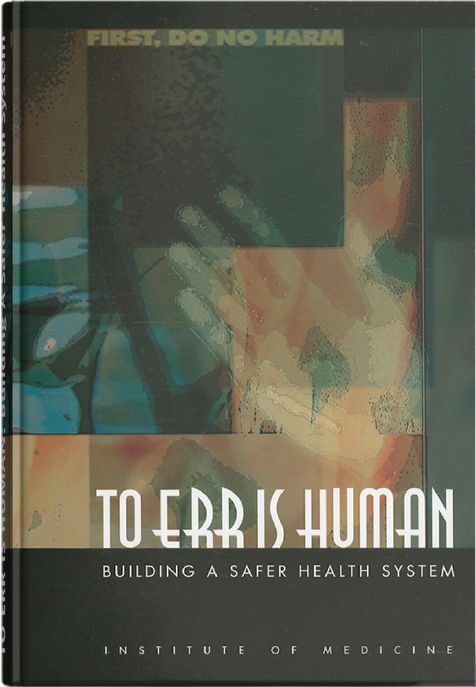Patient Safety and Quality:
Improving the Standard of Care for All

The culture of health care has traditionally been paternalistic, with the view that clinicians know what’s best for their patients. Since 1970, the realization has grown that a patient-centered culture is a feature of safe and reliable health care systems, and patient safety has come to be a core competency in the health professions and in health care systems. Nevertheless, errors continue to occur because of the expense and effort required to change not only organizational systems but also organizational cultures.

1970
Upholding the Safety of Medications
Though the U.S. Food and Drug Administration (FDA) increased efforts to evaluate the effectiveness of drugs during the 1960s, especially after a sleeping pill called thalidomide was found to have caused birth defects in thousands of babies born in Europe, a major turning point came in 1970. A Court of Appeals ruling in Upjohn Company v. Finch held that commercial success alone did not constitute substantial evidence of a drug’s safety and efficacy, a key step in requiring drug manufacturers to prove the effectiveness of their products.


1989
Establishing National Standards for Health Care Research
Established in 1989, the Agency for Healthcare Research and Quality (AHRQ) is the primary federal agency responsible for supporting research to improve the quality, safety, accessibility, affordability, and effectiveness of health care in the United States. Since its creation, AHRQ has concentrated on three core topics—data and analytics, health systems research, and practice improvement. One of its core missions is to promote patient safety through grants, development of tools and resources, and dissemination of best practices.

1980s
Recognizing the Need to Measure and Monitor
During the mid-1980s, the U.S. government mandated that the Department of Veterans Affairs improve its surgical outcomes to reduce the higher mortality rates during operations in its hospitals compared with other hospitals. A national study from 1991 to 1993 led to the launch of the National Surgical Quality Improvement Program (NSQIP), the first national, validated, and outcome-based program for the measurement and enhancement of the quality of surgical care for veterans. By rigorously collecting preoperative and postoperative data, the NSQIP led to new benchmarks for quality care, contributing to a 47 percent drop in postoperative mortality by 2006. The American College of Surgeons has implemented the program in thousands of private-sector hospitals.

1999
Raising the Standard for Quality Care
In 1999, the Institute of Medicine released To Err Is Human: Building a Safer Health System, which presented a comprehensive strategy for the government, health care providers, industry, and consumers to reduce the alarmingly high number of medical errors that occur because of systemic failures in the U.S. health care system. The report—which built on results from an earlier Harvard University study to estimate that 44,000–98,000 deaths occur per year from medical errors in the United States—launched the patient safety movement. The report sounded the alarm on an issue that was not previously on the radars of health care institutions, policymakers, and the American public. It directly spurred action to address previously unchecked, preventable medical errors that were contributing to a high number of deaths of those seeking care, and caused a drastic transformation in the culture of care quality and patient safety. To support the report’s goal of halving medical errors over 5 years, President Bill Clinton launched a series of patient safety initiatives, including the reauthorization of the Agency for Healthcare Quality and Research.

1999
Establishing a National Organization to Ensure Quality
Based on recommendations by President Bill Clinton’s Advisory Commission on Consumer Protection and Quality in the Health Care Industry, the National Quality Forum (NQF) was established in 1999 to promote and ensure patient protections and health care quality through measurement and public reporting. Review and endorsement by NQF are now considered the gold standard in the use of metrics to improve health care quality. The NQF also recommends performance-based measures for use in payment and public reporting programs, advances electronic quality-improvement measurement, and identifies and accelerates quality improvement priorities.

2005
Encouraging Reporting to Improve Patient Safety and Policy
The Patient Safety and Quality Improvement Act of 2005 created a voluntary reporting system organized around Patient Safety Organizations to improve the data needed to assess and resolve issues involving patient safety and health care quality. To encourage providers to report patient safety events without fear of increased liability or risk, the act also provided federal confidentiality protections for patient safety information. The act’s emphasis on evidence and analysis has allowed for a better understanding of events that adversely affect patients, contributing to more effective strategies to improve patient safety.

2002
Ensuring the Safety of Drugs Prescribed to Children
Federal legislation and regulations require that prescription drugs be tested for safety and efficacy before they are approved by the U.S. Food and Drug Administration. However, far more drugs have been studied and approved for clinical use in adults than in pediatric populations, leading to a high level of “off-label” prescriptions for children without an adequate understanding of appropriate dose, safety, or efficacy. To improve the safety and efficacy of such medicines, Congress passed the Best Pharmaceuticals for Children Act in 2002. The act incentivizes the pharmaceutical industry to perform pediatric studies to improve labeling for patented drug products used in children and authorizes the National Institutes of Health to support clinical trials in the pediatric population.

2006
Enforcing Established Privacy Standards
The 2006 Health Insurance Portability and Accountability Act (HIPAA) Enforcement Rule gave the U.S. Department of Health and Human Services the power to investigate complaints against entities for failing to comply with the patient privacy protections under HIPAA and to issue fines for avoidable breaches arising from failure to follow safeguards. This development underscored the roles of privacy and confidentiality as cornerstones of patient safety. By establishing concrete and standardized consequences for violating HIPAA regulations, the Enforcement Rule minimized confusion and reinforced the importance of compliance with HIPAA.

Though patient safety has improved since 1970, progress has been slower than was expected after the release of the Institute of Medicine’s 1999 report To Err Is Human. The challenge is complex, involving not just direct patient treatment but skills such as teamwork, communication, and accountability. The central concept of the patient safety field—that most errors represent systems failures rather than individual failures—has led to a major rethinking of how care is organized and delivered, but achieving a safe and reliable health care system will require establishment of a framework for both continuous improvement and sustainability.




